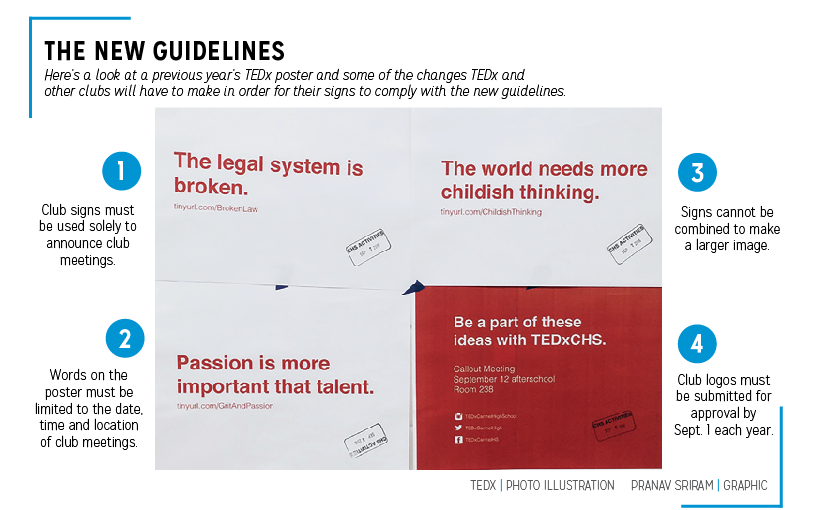

TEDx officers (starting from left) Selin Oh, Shubhi Sinha, Shae Rickel and Hannah Paul discuss poster designs for their upcoming event. The club said it plans on meeting with Wiseman for poster approval soon.
According to the center for Public Education, students’ freedom of speech at school has been a conflicting issue throughout the United States’ history. The recurrence of this conflict has resulted in a recent update to CHS’s poster policy to delineate students’ freedom of expression. (See “Poster Premise” at bottom.)
Selin Oh, TEDx officer and sophomore, said she feels the updated policies overbear on a student’s freedom to speech. Additionally, she said the new policies defeat the overarching ideology of TEDx.
“Personally, I’m definitely not the strongest proponent of these new restrictions. The ideology of TEDx is ‘ideas worth spreading,’ which is kind of the opposite of what’s going on here. I think that’s an important value,” Oh said. “Obviously, there needs to be some sort of balance. We need to be able to foster a conducive environment to be able to talk about controversial topics. I don’t think it’s right to just stick up a poster without any conversation to follow it, but on the other hand, I don’t that it’s right to totally ban (freedom of speech).”
Furthermore, according to Oh, given that students spend a majority of their time at school, it is important that polite discussions are propagated through posters and signage.

“It’s a little disheartening to see that the only posters that can be up on the walls are words and the only images are logos. In a sense, it almost dehumanizes the school. For instance, our callout posters were in sets of four and so one of them had the logistical information, but the other three were ideas put out in some popular TED Talks. Based on these new changes, it seems like we aren’t able to do something like that now,” Oh said.
Besides the necessity to maintain a safe student environment, Principal John Williams also said that administrators would like to limit the amount of posters in the school in order to maintain a neat physical environment.
“Some of this is just aesthetics, too. One of the things that we pride ourselves on is how clean our school is. We would not want to have our Commons with people sticking up whatever they would want to put up. And it happens from time to time.” Williams said.
According to Assistant Principal Brittany Wiseman and Williams, CHS has dealt with similar issues where an established school policy was updated, and they said such a change is not a first.
“In any policy that we change, sometimes those changes are brought about because the wording was misleading and new situations arise,” Williams said. “Administration has a formal process where we go through our handbook and look at what changes would be appropriate or beneficial. For instance, our policies on Academic Dishonesty, headphones, and cell phones were changed a few years ago.”
According to Wiseman, coming to a consensus on what is a “right” policy varies with the complexity of the issue.
Wiseman said, “Some (decisions) are ‘Duh,’ and (others) are where we will talk to some other people and those might take them longer. Basically, our intent is to be purposeful about our decisions. My belief is that, in high school, you should have a minimum amount of rules you have to keep your building running.”
For her part, Oh said she hopes students’ voices are encouraged to be heard more when trying to decide on policies to enact.
“Honestly, I feel I’m often on the receiving end and these rules just emphasize that feeling,” Oh said. “We’re the ones who are being affected by such changes, and I feel us students should be included in such discussions. More specific to this, I hope a conversation about this is encouraged and the school can learn more from an experience like this.”
However, Wiseman said students are highly encouraged to speak to any administrator should they have any concern against policies of any kind.
Wiseman said, “I think a student could go to any administrator, but there are many avenues. The key is that it’s important that students know they have a right to say what they feel. If someone has an idea, we encourage them to make us aware of it and they can even use an anonymous alert if they wish to not have their name tied to it.”
Looking into the future, Williams said policies may change based upon new technological advancements and growing changes in society.
Williams said, “The role of leaders is to evaluate as a situation occurs, and decide what appropriate changes need to be made. We can change a policy in five minutes and we can make exceptions to them also. That’s the job of leadership. That’s why we’re constantly evaluating our policies. As technology evolves, we have to look into that.”

Poster Premise: Administrators discuss reasons for new poster policy.
According to both Principal John Williams and Assistant Principal Brittany Wiseman, new poster policies were implemented as a result of a controversial anti-abortion poster put up last November by members of the Teens for Life Club. After discussion among administrators over winter break, the policy related to posters was immediately updated as of the beginning of this semester. The club has now been cleared to put their poster back up. Members of the Teens for Life Club declined to comment for this story.
On the new policy, Wiseman said, “Once (a poster) is made, it usually takes about a day or two to get approved, and then they get a stamp. There’s a certain number (of posters) that can go in each of the cafeterias, and then if for some reason there would be a (poster) that has not been approved or been questioned, it’ll be taken down and given back to me, and then I contact the club sponsor and have a conversation with the sponsor and the club leader.”
The previous poster policy had some ambiguity in its wording, with no exact dimensions and sizes given. This resulted in confusion regarding what exactly students could put on posters. Williams said the intent of signs, to describe the location of a club meeting or event, has not changed at all, but he said administrators have simply done a better job of being clear of what is expected of students.
“The hope and the intent for signs is to get more people involved in student interest clubs,” Wiseman said. “We want students to know, ‘Okay, so what do we offer at school?’ The hope is if I see a sign for (a club)… I’m going to go show up there so I can go be a part of that group. That’s why we have the signs.”































![What happened to theater etiquette? [opinion]](https://hilite.org/wp-content/uploads/2025/04/Entertainment-Perspective-Cover-1200x471.jpg)














































![Review: “The Immortal Soul Salvage Yard:” A criminally underrated poetry collection [MUSE]](https://hilite.org/wp-content/uploads/2025/03/71cju6TvqmL._AC_UF10001000_QL80_.jpg)
![Review: "Dog Man" is Unapologetically Chaotic [MUSE]](https://hilite.org/wp-content/uploads/2025/03/dogman-1200x700.jpg)
![Review: "Ne Zha 2": The WeChat family reunion I didn’t know I needed [MUSE]](https://hilite.org/wp-content/uploads/2025/03/unnamed-4.png)
![Review in Print: Maripaz Villar brings a delightfully unique style to the world of WEBTOON [MUSE]](https://hilite.org/wp-content/uploads/2023/12/maripazcover-1200x960.jpg)
![Review: “The Sword of Kaigen” is a masterpiece [MUSE]](https://hilite.org/wp-content/uploads/2023/11/Screenshot-2023-11-26-201051.png)
![Review: Gateron Oil Kings, great linear switches, okay price [MUSE]](https://hilite.org/wp-content/uploads/2023/11/Screenshot-2023-11-26-200553.png)
![Review: “A Haunting in Venice” is a significant improvement from other Agatha Christie adaptations [MUSE]](https://hilite.org/wp-content/uploads/2023/11/e7ee2938a6d422669771bce6d8088521.jpg)
![Review: A Thanksgiving story from elementary school, still just as interesting [MUSE]](https://hilite.org/wp-content/uploads/2023/11/Screenshot-2023-11-26-195514-987x1200.png)
![Review: "When I Fly Towards You", cute, uplifting youth drama [MUSE]](https://hilite.org/wp-content/uploads/2023/09/When-I-Fly-Towards-You-Chinese-drama.png)
![Postcards from Muse: Hawaii Travel Diary [MUSE]](https://hilite.org/wp-content/uploads/2023/09/My-project-1-1200x1200.jpg)
![Review: "Ladybug & Cat Noir: The Movie," departure from original show [MUSE]](https://hilite.org/wp-content/uploads/2023/09/Ladybug__Cat_Noir_-_The_Movie_poster.jpg)
![Review in Print: "Hidden Love" is the cute, uplifting drama everyone needs [MUSE]](https://hilite.org/wp-content/uploads/2023/09/hiddenlovecover-e1693597208225-1030x1200.png)
![Review in Print: "Heartstopper" is the heartwarming queer romance we all need [MUSE]](https://hilite.org/wp-content/uploads/2023/08/museheartstoppercover-1200x654.png)


